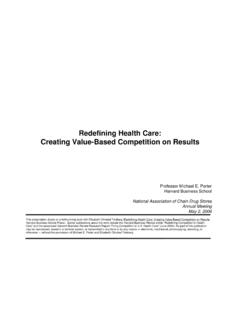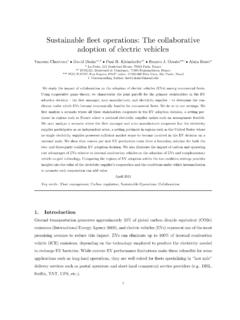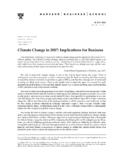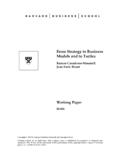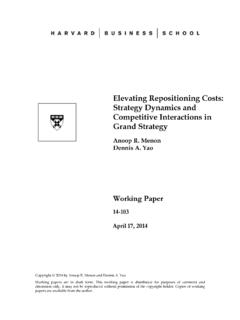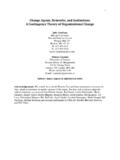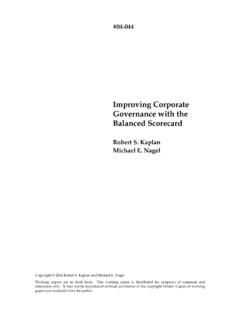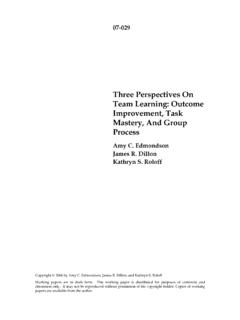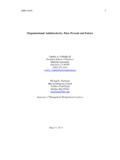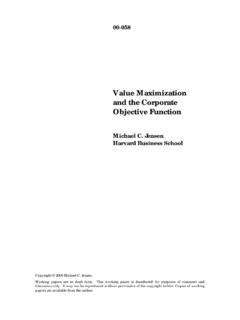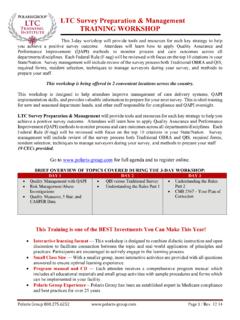Transcription of Reviews, Reputation, and Revenue: The Case of Yelp
1 Reviews, Reputation, and Revenue: The Case of Michael Luca Working Paper 12-016 Working Paper 12-016 Copyright 2011, 2016 by Michael Luca Working papers are in draft form. This working paper is distributed for purposes of comment and discussion only. It may not be reproduced without permission of the copyright holder. Copies of working papers are available from the author. Reviews, Reputation, and Revenue: The Case of Michael Luca Harvard Business School Reviews, Reputation, and Revenue: The Case of Michael Luca Abstract Do online consumer reviews affect restaurant demand? I investigate this question using a novel dataset combining reviews from the website and restaurant data from the Washington State Department of Revenue.
2 Because Yelp prominently displays a restaurant's rounded average rating, I can identify the causal impact of Yelp ratings on demand with a regression discontinuity framework that exploits Yelp s rounding thresholds. I present three findings about the impact of consumer reviews on the restaurant industry: (1) a one-star increase in Yelp rating leads to a 5-9 percent increase in revenue, (2) this effect is driven by independent restaurants; ratings do not affect restaurants with chain affiliation , and (3) chain restaurants have declined in market share as Yelp penetration has increased. This suggests that online consumer reviews substitute for more traditional forms of reputation.
3 I then test whether consumers use these reviews in a way that is consistent with standard learning models. I present two additional findings: (4) consumers do not use all available information and are more responsive to quality changes that are more visible and (5) consumers respond more strongly when a rating contains more information. Consumer response to a restaurant s average rating is affected by the number of reviews and whether the reviewers are certified as elite by Yelp, but is unaffected by the size of the reviewers Yelp friends network. Harvard Business School, 2 1 Introduction Technological advances over the past decade have led to the proliferation of consumer review websites such as , where consumers can share experiences about product quality.
4 These reviews provide consumers with information about experience goods, which have quality that is observed only after consumption. With the click of a button, one can now acquire information from countless other consumers about products ranging from restaurants to movies to physicians. This paper provides empirical evidence on the impact of consumer reviews in the restaurant industry. It is a priori unclear whether consumer reviews will significantly affect markets for experience goods. On the one hand, existing mechanisms aimed at solving information problems are imperfect: chain affiliation reduces product differentiation, advertising can be costly, and expert reviews tend to cover small segments of a Consumer reviews may therefore complement or substitute for existing information sources.
5 On the other hand, reviews can be noisy and difficult to interpret because they are based on subjective information reflecting the views of a non-representative sample of consumers. Further, consumers must actively seek out reviews, in contrast to mandatory disclosure and electronic commerce settings. 2 How do online consumer reviews affect markets for experience goods? Using a novel data set consisting of reviews from the website and revenue data from the Washington State Department of Revenue, I present three key findings: (1) a one-star increase in Yelp rating leads to a 5-9 percent increase in revenue, (2) this effect is driven by independent restaurants; ratings do not affect restaurants with chain affiliation , and (3) chain restaurants have declined in 1 For example, Zagat covers only about 5% of restaurants in Los Angeles, according to Jin and Leslie (2009).
6 2 For an example of consumer reviews in electronic commerce, see Cabral and Hortacsu (2010). For an example of the impact of mandatory disclosure laws, see Mathios (2000), Jin and Leslie (2003), and Bollinger et al. (2010). 3 revenue share as Yelp penetration has increased. Consistent with standard learning models, consumer response is larger when ratings contain more information. However, consumers also react more strongly to information that is more visible, suggesting that the way information is presented matters. To construct the data set for this analysis, I worked with the Washington State Department of Revenue to gather revenues for all restaurants in Seattle from 2003 through 2009.
7 This allows me to observe an entire market both before and after the introduction of Yelp. I focus on Yelp because it has become the dominant source of consumer reviews in the restaurant industry. For Seattle alone, the website had over 60,000 restaurant reviews covering 70% of all operational restaurants as of 2009. By comparison, the Seattle Times has reviewed roughly 5% of operational Seattle restaurants. To investigate the impact of Yelp, I first show that changes in a restaurant s rating are correlated with changes in revenue, controlling for restaurant and quarter fixed effects. However, there can be concerns about interpreting this as causal if changes in a restaurant s rating are correlated with other changes in a restaurant s reputation that would have occurred even in the absence of Yelp.
8 This is a well-known challenge to identifying the causal impact of any type of reputation on demand, as described in Eliashberg and Shugan (1997). To support the claim that Yelp has a causal impact on revenue, I exploit the institutional features of Yelp to isolate variation in a restaurant s rating that is exogenous with respect to unobserved determinants of revenue. In addition to specific reviews, Yelp presents the average rating for each restaurant, rounded to the nearest half-star. I implement a regression discontinuity (RD) design around the rounding thresholds, taking advantage of this feature. Essentially, I look for discontinuous jumps in revenue that follow discontinuous changes in 4 rating.
9 One common challenge to the RD methodology is gaming: in this setting, restaurants may submit false reviews. I then implement the McCrary (2008) density test to rule out the possibility that gaming is biasing the results. If gaming were driving the result, then one would expect ratings to be clustered just above the discontinuities. However, this is not the case. More generally, the results are robust to many types of firm manipulation. Using the RD framework, I find that a restaurant s average rating has a large impact on revenue - a one-star increase leads to a 5-9 percent increase in revenue for independent restaurants, depending on the specification. The identification strategy used in this paper shows that Yelp affects demand, but is also informative about the way that consumers use information.
10 If information is costless to use, then consumers should not respond to rounding, since they also see the underlying reviews. However, a growing literature has shown that consumers do not use all available information (Dellavigna and Pollet 2007; 2010). Further, responsiveness to information can depend not only on the informational content, but also on the simplicity of calculating the information of interest (Chetty et al. 2009, Finkelstein 2009). Moreover, many restaurants on Yelp receive upward of two hundred reviews, making it time-consuming to read them all. Hence, the average rating may serve as a simplifying heuristic to help consumers learn about restaurant quality in the face of complex information.
